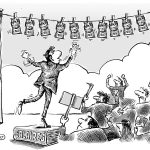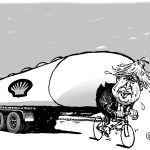Desperately seeking lorry drivers
Should we really fear energy shortages this winter?
Queues and aggressive reaction at uk petrol stations, soaring electricity and natural gas prices there and elsewhere, media saturations and rumours of all kinds, it does not take more to raise fears of severe shortages as the winter approaches awakening the specter of the oil shocks of the 1970s. Thus, we have gone from the anguish of deflation to the ghosts of stagflation in just a few months.
More than a lasting inflationary risk, wouldn’t it be a simple resurgence of Murphy’s Law? The accumulation of bottlenecks, the combination of annoying technical and climatic circumstances, cartel markets, are all factors of tension that could nevertheless prove temporary.
The economic recovery supported by public policies has pushed up the final demand for goods beyond the productive and logistical capacities of many sectors. With a reversed front compared to 2008, America and Europe are the engines of this acceleration while China – the factory of (almost) everyone – slows down. In addition, the accelerated and disorderly shift out of coal (many regions in China have stopped their activity because they have not met the CO2 emission reduction targets imposed by Beijing), has sharply reduced production capacity and increased the demand for imports of other energy sources for the Middle Kingdom.
It must be noted that a climate transition in good order and at controlled costs is not yet assured.
In Europe, natural gas stocks were still low in the spring, while the supply is more contained than expected. “Controlled” management of gas pipelines, maximum use of liquefaction capacity, LNG carriers delivering to the highest bidder, over-indebted shale gas producers, recent rise in prices also makes it possible to compensate for the decreases of past years. The same goes for oil: OPEC+ is managing its quotas quite effectively, after the calamitous fall in revenues in 2020. For the first time since 2014, the price of a barrel of Brent is above $80.
These cumulative stresses are pushing electricity costs, whose share in the overall demand of energies is only growing. It has increased worldwide from 9.5% in 1973 to 19.7% in 2019, according to the International Energy Agency. They suggest, however, that there is indeed room for adjustment of supply when prices rise sufficiently.
It remains to manage the human factor and the climatic hazard. In the United States as in Europe, the aging of the population, the arduousness and more recently the pandemic, have considerably reduced the number of qualified drivers. In the UK, post-Brexit exile did the rest.
On the climate side, the lack of wind in Germany and the low level of water reserves in Norway have helped to limit the use of alternative energies. While the risks of short-term shortages can be reasonably ruled out, it must be noted that a climate transition in good order and at controlled costs is not yet assured.
Undoubtedly, the recent increase in production costs is clearly reflected in final prices and weighs on purchasing power. The Central Banks, as they reaffirmed at the meeting organised by the ECB on 29th September last, are sticking to their position: the current pressures are temporary. It is necessary to support the climate transition and promote the efforts of States in this direction.
©Article published in AllNews.ch on Sep29, 2020 ®Cartoon Barret



